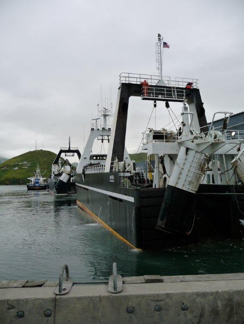 “Our precautionary approach to fishery management continues to provide sustainable seafood to millions,” said MCA President Frank Kelty.
“Our precautionary approach to fishery management continues to provide sustainable seafood to millions,” said MCA President Frank Kelty.
The North Pacific Fishery Management Council (“NPFMC”) has unanimously approved its recommendations for the 2011 Bering Sea and Aleutian Islands (“BSAI”) groundfish total allowable catch (TAC) limits. For 2011, the pollock and pacific cod catch limits are both up significantly, reflecting strong growth in those fish populations.
The Council annually establishes catch limits for nearly a dozen species that make up the productive BSAI ecosystem. For 2011, the catch limits for two of the major species in the Bering Sea have been increased significantly. The pollock catch limit has increased by 54% over 2010, and the pacific cod catch limit has been increased by 35%.
“The Marine Conservation Alliance fully supports the Council’s recommendations,” said President Frank Kelty. “For more than 30 years, strict annual catch limits for the federal fisheries off the coast of Alaska have protected our clear, pristine waters and abundant ecosystem, which continues to feed tens of millions of people throughout the world.”
The groundfish catch limits are established annually, based on advice from scientists from the Alaska Fisheries Science Center (NOAA), the Alaska Department of Fish and Game, and other agencies and universities; as well as the Council’s Scientific and Statistical Committee and Advisory Panel, and public testimony.
Additional details of the Council’s decision on quotas are:
| Species | Area | 2010 TAC |
2011 TAC |
| Pollock | EBS | 813,000 | 1,252,000 |
| AI | 19,000 | 19,000 | |
| Bogoslof | 50 | 150 | |
| Pacific Cod | BSAI | 168,780 | 227,950 |
| Sablefish | BS | 2,790 | 2,850 |
| AI | 2,070 | 1,900 | |
| Yellowfin Sole | BSAI | 219,000 | 196,000 |
| Greenland Turbot | BS | 4,220 | 3,500 |
| AI | 1,900 | 1,550 | |
| Arrowtooth Flounder | BSAI | 75,000 | 25,900 |
| Kamchatka Flounder | BSAI | NA | 17,700 |
| Northern Rock Sole | BSAI | 90,000 | 85,000 |
| Flathead Sole | BSAI | 60,000 | 41,548 |
| Alaska Plaice | BSAI | 50,000 | 16,000 |
| Other Flatfish | BSAI | 17,300 | 3,000 |
| Pacific Ocean Perch | BSAI | 18,860 | 24,700 |
| Northern Rockfish | BSAI | 7,240 | 4,000 |
| Rougheye | BSAI | 547 | 454 |
| Shortraker Rockfish | BSAI | 387 | 393 |
| Other Rockfish | BSAI | 1,040 | 1,000 |
| Atka Mackerel | EAI/BS | 23,800 | 40,300 |
| CAI | 29,600 | 11,280 | |
| WAI | 20,600 | 1,500 | |
| Squid | BSAI | 1,970 | 425 |
| Other Species | BSAI | 50,000 | NA |
| Skate | BSAI | NA | 16,500 |
| Shark | BSAI | NA | 50 |
| Octopus | BSAI | NA | 150 |
| Sculpin | BSAI | NA | 5,200 |
|
Total |
1,677,154 | 2,000,000 | |
The catcher vessel AURIGA sits dockside in Dutch Harbor awaiting its next pollock trip. Photo courtesy of Mary McDowell, Pacific Seafood Processors Association.
Contacts:
- Frank Kelty, President, MCA, (907) 523-0731
- Dave Witherell, NPFMC Deputy Director, (907) 271-2809
- Jim Ianelli, pollock stock assessment biologist NMFS, (206) 526-6510
- Pat Livingston, Chair NPFMC Scientific and Statistical Committee (SSC) (206) 526-4172
Dr. Doug DeMaster, Science and Research Director, Alaska Fishery Science Center, (206) 526-4047
More information on the Marine Conservation Alliance and the SeaAlliance campaign is available at:
Web http://www.marineconservationalliance.org/
FaceBook http://www.facebook.com/SeaAlliance
Twitter http://twitter.com/SeaAlliance
YouTube http://www.youtube.com/user/SeaAlliance
The Juneau-based Marine Conservation Alliance is a coalition of seafood processors, harvesters, support industries and coastal communities that are active in Alaska fisheries. The MCA represents approximately 75 percent of the participants in Alaska shellfish and groundfish fisheries and promotes science based conservation measures to ensure sustainable fisheries in Alaska. For more information, click on http://www.marineconservationalliance.org/
